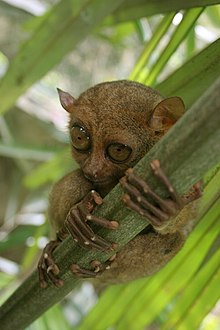Carlito (genus)
| Philippine tarsier | |
|---|---|
 |
|
| Scientific classification | |
| Kingdom: | Animalia |
| Phylum: | Chordata |
| Class: | Mammalia |
| Order: | Primates |
| Family: | Tarsiidae |
| Genus: |
Carlito Groves & Shekelle, 2010 |
| Species: | C. syrichta |
| Binomial name | |
|
Carlito syrichta (Linnaeus, 1758) |
|
 |
|
| Geographic distribution of Philippine tarsier | |
The Philippine tarsier (Carlito syrichta), known locally as mawmag in Cebuano/Visayans and mamag in Luzon, is a species of tarsier endemic to the Philippines. It is found in the southeastern part of the archipelago, particularly on the islands of Bohol, Samar, Leyte and Mindanao. It is a member of the approximately 45-million-year-old family Tarsiidae, whose name is derived from its elongated "tarsus" or ankle bone. Formerly a member of the genus Tarsius, it is now listed as the only member of the genus Carlito, a new genus named after the conservationist Carlito Pizarras.
Its geographic range also includes Maripipi Island, Siargao Island, Basilan Island and Dinagat Island. Tarsiers have also been reported in Sarangani, although they may be different subspecies.
It was introduced to Western biologists during the 18th century.
The Philippine tarsier measures only about 85 to 160 mm (3.35 to 6.30 in) in height, making it one of the smallest primates. The small size makes it difficult to spot. The mass for males is between 80–160 g (2.8–5.6 oz), usually lighter for females, somewhat heavier than other tarsiers such as the pygmy tarsier. The average adult is about the size of a human fist.
The female tarsier has multiple sets of breasts, but the only functional set is at the pectoralis. The other breasts are used as anchor points for the newborn tarsiers. The gestation period lasts 180 days, or 6 months, after which only one tarsier is born. The newborn tarsier is born with much fur and eyes open. Its body and head length is about 70 mm, and its tail is around 115 mm long.
...
Wikipedia

